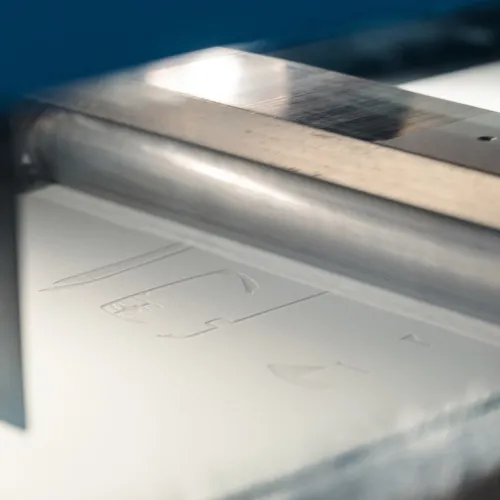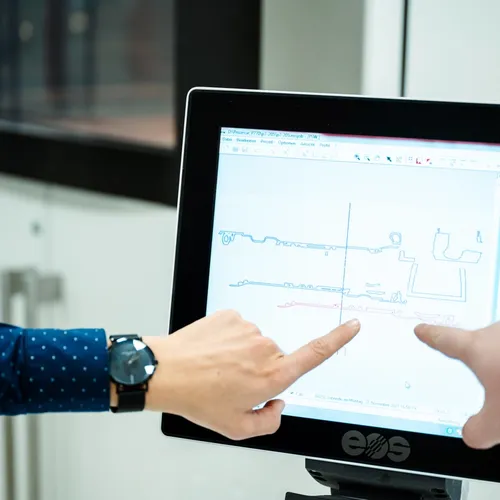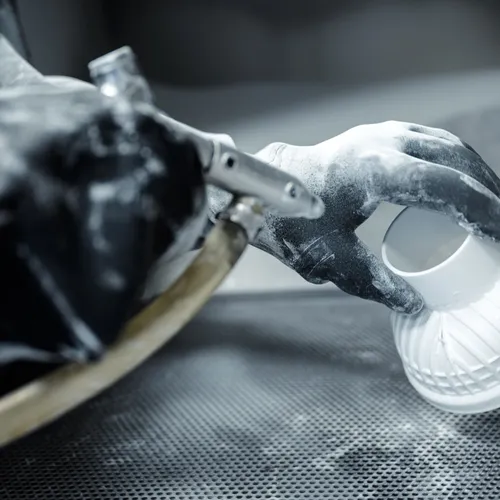
Selective Laser Sintering
Interesting facts about 3D printing technology
The relevance of selective laser sintering lies in its ability to produce customized prototypes and components with complex details and high strength. This technology is particularly interesting for industries that need to respond quickly and efficiently to market needs, such as the automotive, medical technology, and aerospace industries.
By combining versatility and material diversity, SLS enables both the development of new products and the optimization of existing designs – all with an efficiency that traditional manufacturing methods cannot offer.
Maximum data protection
Your data is in safe hands with us
35 years of experience
Resilient prototypes for your projects
Efficiency
Combination of versatility and material diversity
For every industry
From automotive to dentistry
Well advised
Reach your goal quickly with our experts
Maximum data protection
Your data is in safe hands with us
35 years of experience
Resilient prototypes for your projects
Efficiency
Combination of versatility and material diversity
For every industry
From automotive to dentistry
Well advised
Reach your goal quickly with our experts
From Powder to Component
An introduction to the manufacturing process
Thanks to the combination of versatility and material diversity, SLS enables both the development of new products and the optimization of existing designs - and all this with an efficiency that traditional production methods cannot offer.
THE COURSE OF THE PROCEDURE
1. Powder Coating
First, a thin layer of the desired material—often polyamide (nylon), but also TPU or various metals—is evenly applied to the build platform. The material is spread precisely using a recoater blade.

Powder layer in the SLS system.
2. Laser Sintering
A high-precision laser beam heats the defined areas of the powder layer to the sintering temperature. In these areas, the particles fuse into a solid structure without fully melting.
The laser is computer-controlled, accurately reproducing the geometry of the component based on CAD data.

Precise monitoring of all processes.
3. Layered structure
Printed, robust and strong standard materials.
After the first layer is sintered, the build platform lowers slightly, and a new layer of powder is applied. This process is repeated until the entire component is built.
The layer thickness typically ranges between 0.05 and 0.15 mm, enabling precise representation of even fine details.

Melting the SLS powder
4. Cooling and post-processing
After the build process is complete, the component must cool within the powder bed to prevent stress and deformation. The excess powder surrounding the component can then be removed and is often reusable.
If necessary, post-processing follows to clean the component and, if needed, smooth or color its surfaces.

Cleaning the SLS component after removal from the powder bed.
Materials for selective laser sintering
Typical SLS Plastic Materials and Their Properties
Polyamide (Nylon)
Nylon is one of the most commonly used materials in the SLS process. It is a thermoplastic with balanced mechanical properties and a fine surface resolution. It stands out for its high strength, good chemical resistance, and flexibility. The material is also highly resistant to stress cracking, even in the presence of chemicals, and effectively dampens noise and vibrations. Nylon parts are suitable for both functional prototypes (functional testing) and end products (low to medium production volumes), as they are durable and mechanically robust.
TPU (Thermoplastic Polyurethane)
TPU is flexible, elastic, and abrasion-resistant, making it particularly suitable for applications where the part requires a certain degree of stretchability or impact absorption. This is especially relevant in the medical and automotive industries.
Reinforced Plastics
SLS can also work with glass- or carbon-fiber-reinforced plastics to produce parts with even higher strength and stiffness. These materials are frequently used in the automotive and aerospace industries, where durability and weight are critical factors.
Selective laser sintering in practice
Areas of application and industry solutions
Selective Laser Sintering (SLS) has established itself across a wide range of industries due to its flexibility and precision. Whether in the development of functional prototypes, the production of small series, or the manufacturing of specialized end products, the SLS process enables tailored solutions precisely aligned with the requirements of the respective industries.
SLS-Prototypes
SLS in prototyping enables fast results with high precision. As the process reliably produces complex geometries and intricate structures, designers and engineers can create detailed and functional prototypes suitable for testing and validation.
Medical
Technology
SLS applied in medical technology enables the production of biocompatible and sterilizable components that can be specifically tailored to a patient’s anatomy. This is particularly advantageous for orthopedic devices, dental implants, and medical instruments.
Automotive
Industry
SLS enables the production of functional components that can be used for testing under real-world conditions. From interior parts to panels, the ability to manufacture lightweight yet durable plastic components makes SLS an indispensable tool for the development and validation of new vehicle components.
Aerospace
The aerospace industry benefits significantly from SLS's ability to produce highly precise and lightweight components. The technology enables the production of geometrically complex structures that are not only capable of withstanding high stresses but are also optimized for weight and functionality.
Diversity in 3D Printing
SLS in pictures




Advantages of selective laser sintering
Selective laser sintering (SLS) is one of the most popular additive manufacturing technologies because it offers companies an impressive range of possibilities. Compared to traditional methods and other 3D printing techniques, SLS provides unique advantages in terms of design freedom, material properties, and manufacturing efficiency.
- High design freedom and complexity without tools
One of the standout advantages of the SLS process is the freedom in design. Since no support material is required, even the most complex geometries, intricate structures, and interlocking assemblies can be produced without additional tools or molds. This allows for designs that are difficult or impossible to achieve using conventional methods. Prototypes and functional models can be created in a very short time—without the limitations imposed by tools and molds.
- Material variety and excellent material properties
The SLS process is suitable for a wide range of materials, including robust plastics such as nylon, TPU, and glass- or carbon-fiber-reinforced polymers. These materials offer high mechanical strength, durability, and flexibility. Components produced using SLS often exhibit high stability and resistance, comparable to injection-molded plastic parts. This makes SLS ideal for functional prototypes that must withstand real-world conditions, as well as for end products that require longevity.
- Speed and efficiency in the manufacturing process
SLS provides a fast way to produce functional components and prototypes. The layer-by-layer technology and automatic laser sintering ensure that prototypes and small series can be produced in a short time. Companies can respond quickly to market developments and accelerate their product development. Additionally, the elimination of mold-making and tool manufacturing speeds up the process and significantly reduces upfront costs.
- Cost-effectiveness for small series and custom productions
SLS is particularly suitable for small series and the production of customized products, as it does not require expensive tools. This makes it possible to economically produce small series and unique items, which is especially valuable for industries such as medical technology or the consumer goods market. For product development that requires quick iteration and adaptation, the SLS process provides a cost-effective solution to create and test variations without the expense of changing tools.
- Outstanding characteristics for functional prototypes
Thanks to the high level of detail and strength of SLS parts, engineers and designers can develop functional prototypes that can withstand real-world conditions—whether for heat tests, stress tests, or other extreme scenarios. The SLS process enables the production of robust prototypes that already meet key requirements of the final product. This ensures that design and functionality can be thoroughly tested and optimized during the development phase.
- Sustainability and material reusability
Another advantage of the SLS process is the ability to reuse unsintered powder. Since the excess powder does not fuse during production, it can be reused for subsequent print runs. This reduces material waste and makes SLS a more resource-efficient manufacturing method compared to processes that require support structures or tools. For companies with high sustainability requirements, this is a crucial advantage.
Our case studies
Automotive
A body with class: We produced the master model for the body of the cult Evetta light electric vehicle on a 1:1 scale – with perfect milling and the finest surface finishing. Find out how.
Industry
The socket for the forest: We developed the prototypes for a type of powerbank for Stihl, which was put through its paces by forestry workers. A truly powerful project.
Aerospace
"Jena, we have no problem": Jena-Optronik commissioned MODELLTECHNIK to produce a 1:1 model of the Gateway Docking Port, which is needed for sensor tests in space applications.
Design
Timeless and dignified: Working with Samosa and our expertise in 3D printing, MODELLTECHNIK creates beautiful templates and design samples for individually designed funeral urns.
Contact us
Whether you’ve got technical, commercial or specialist questions – we’re here to help.
START A QUERY NOW„Spot-on delivery under extreme time pressure [...] It couldn't be more perfect“
„Spot-on delivery under extreme time pressure [...] It couldn't be more perfect“

